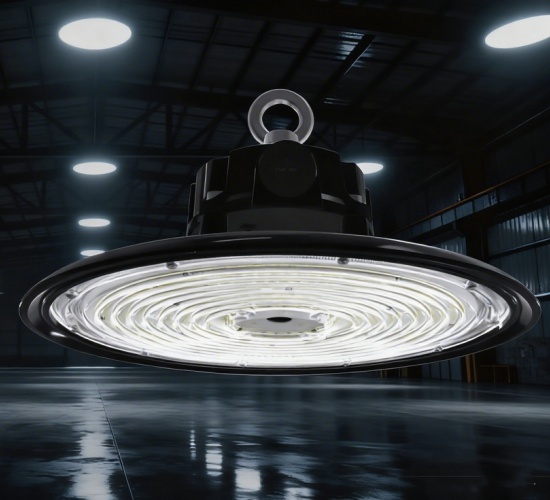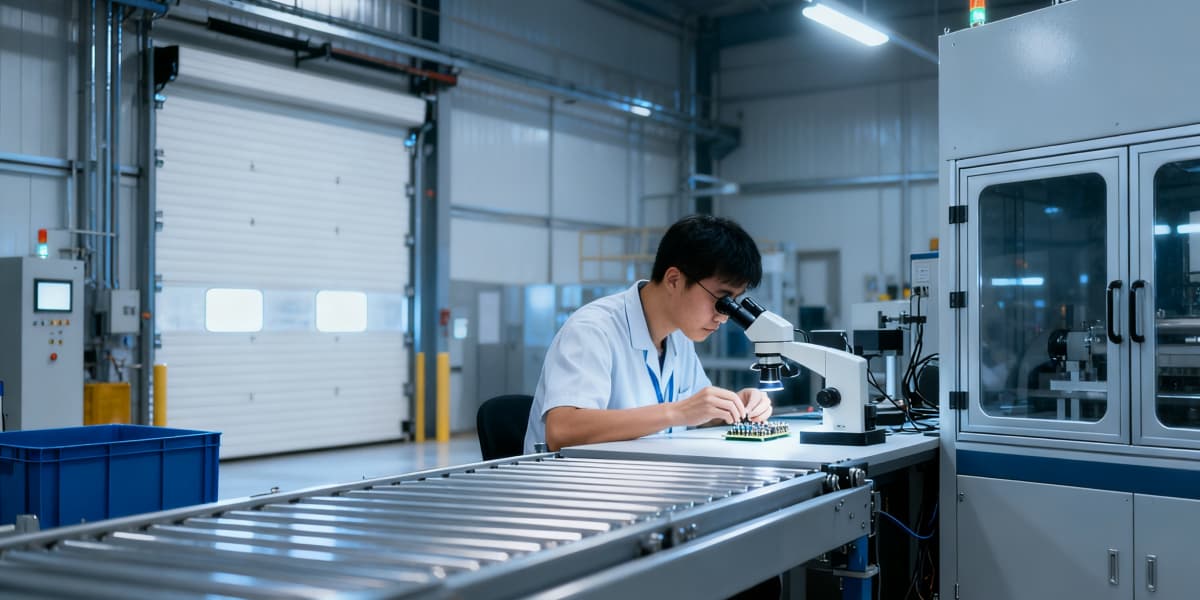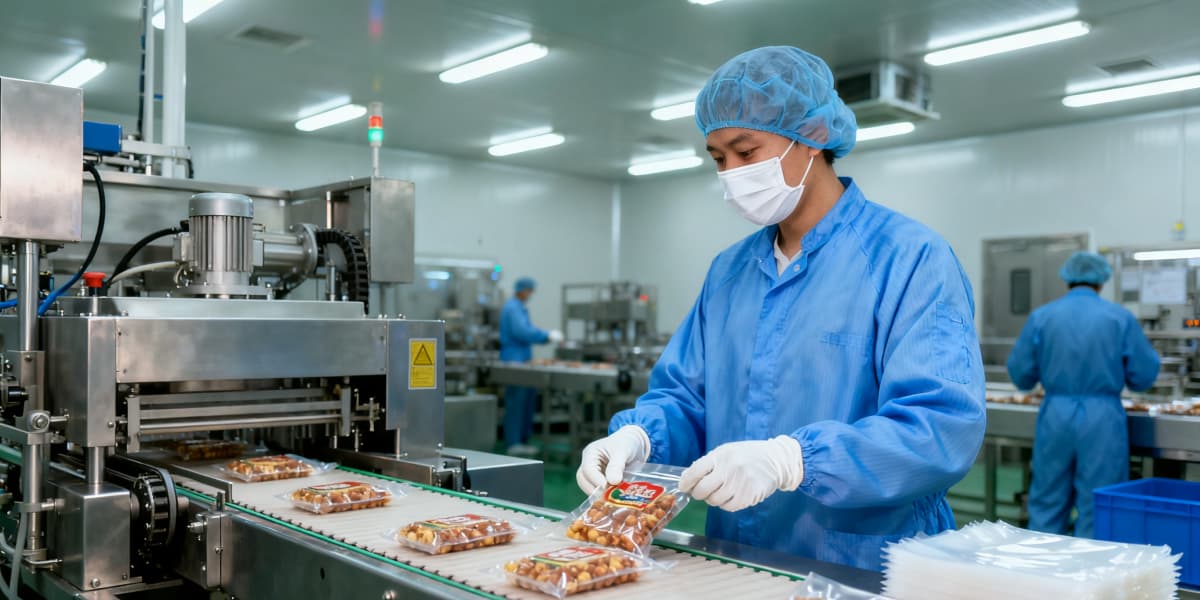Iluminación LED para fábricas: Guía para la iluminación de espacios de trabajo industriales

Directorio:
1. Introducción – Por qué la iluminación en las fábricas es importante
2. Principales desafíos de iluminación en entornos de fábrica
3. ¿Qué características debe tener una buena iluminación LED para fábricas?
4. ¿Cómo elegir las luces LED adecuadas para una fábrica?
5. ¿Cómo planificar la distribución de la iluminación LED en una fábrica?
6. Aplicaciones en el mundo real y estudios de caso
Las luces LED para fábricas son la columna vertebral de la iluminación industrial moderna, ya que proporcionan un brillo potente, una larga vida útil y un ahorro energético significativo para instalaciones de producción, almacenes y talleres.
En comparación con las lámparas tradicionales de halogenuros metálicos o fluorescentes, la iluminación LED garantiza un funcionamiento más seguro, eficiente y ecológico.
En esta guía, exploraremos cómo elegir la luz LED adecuada para fábricas, comprenderemos sus especificaciones técnicas y veremos por qué el cambio a LED es una inversión inteligente para cualquier espacio industrial.
1. Introducción – Por qué la iluminación en las fábricas es importante
La iluminación en las fábricas va mucho más allá del simple brillo: constituye la base de la seguridad, la precisión y la productividad en todos los entornos industriales.
Las instalaciones de gran envergadura suelen funcionar de forma continua y albergan estructuras altas, configuraciones complejas y equipos de gran potencia. Estos espacios requieren una iluminación constante y potente que permita un trabajo preciso y mantenga un ambiente seguro.
Aquí es donde las luces LED industriales marcan la diferencia. En comparación con las lámparas HID o fluorescentes tradicionales, los LED ofrecen mayor luminosidad con un consumo energético significativamente menor. Producen una luz uniforme, evitan el parpadeo y emiten un calor mínimo, además de ofrecer una vida útil hasta cinco veces mayor que la de los sistemas antiguos.
Para los gerentes de fábrica, esto se traduce en menores costos de energía, menor tiempo de inactividad por mantenimiento y una iluminación general más clara en toda la planta de producción.
A medida que la sostenibilidad y el rendimiento cobran mayor protagonismo, las soluciones basadas en LED se convierten en la opción preferida en las modernas instalaciones de fabricación.
Ya sea para actualizar una instalación existente o para planificar una nueva, seleccionar las luces LED adecuadas para la fábrica ayuda a crear un entorno industrial más seguro, que ahorra energía y es más económico.
2. Principales desafíos de iluminación en entornos de fábrica
Los entornos fabriles presentan algunas de las condiciones más exigentes para los sistemas de iluminación. Los techos altos, las amplias zonas de producción, el polvo, la humedad y el calor pueden afectar al rendimiento y la seguridad de la luz. Además, muchas fábricas funcionan las 24 horas del día, los 7 días de la semana, lo que significa que las luminarias deben soportar largas jornadas de funcionamiento sin fallos frecuentes.
Las lámparas tradicionales de halogenuros metálicos o fluorescentes suelen tener dificultades en estas condiciones: tardan en encenderse, pierden brillo con el tiempo y requieren reemplazos frecuentes. Estas deficiencias no solo aumentan los costos de mantenimiento, sino que también incrementan el riesgo de mala visibilidad y accidentes en el lugar de trabajo.
In contrast, LED factory lights are engineered to handle these demanding environments. They deliver steady, flicker-free illumination, maintain color consistency, and operate efficiently even in high-temperature or dusty conditions. With an IP65+ protection rating and advanced heat dissipation, LED lights provide durability that traditional fixtures simply can’t match.
Here’s a quick comparison to illustrate the difference:
Feature | Metal Halide / Fluorescent | LED Factory Lights |
Startup Time | Slow (2–5 minutes) | Instant-on |
Energy Efficiency | 60–80 lm/W | 120–150 lm/W |
Lifespan | ~10,000 hours | 50,000–100,000 hours |
Maintenance | Frequent bulb & ballast replacement | Minimal maintenance |
Heat Output | High | Low |
Brightness Decay | Noticeable after 1 year | Stable over years |
This is why most modern factories are shifting to full-LED lighting systems — they not only improve visibility and safety but also bring long-term savings in energy and maintenance.
Next, let’s take a closer look at what defines a truly high-quality LED factory light and which features you should focus on before making a purchase.
3. What Makes a Good LED Factory Lighting?
When it comes to high bay LED lights for factories, performance and reliability are everything. A well-designed LED factory light should not only illuminate large spaces evenly but also withstand harsh working conditions such as heat, dust, and moisture.
Below are the key technical features that define a high-quality factory lighting system.
(1) High Luminous Efficacy (≥130 lm/W)
Energy efficiency directly affects long-term operating costs. The best factory LED lights deliver at least 130 lumens per watt, converting more power into visible light rather than heat. This high efficacy means brighter illumination with lower electricity bills — a critical advantage for large-scale facilities running 24/7.
(2) High Color Rendering Index (CRI ≥80)
A higher CRI ensures that workers can see colors and details accurately, which is especially important for assembly, inspection, and quality control areas. Poor color rendering can cause visual fatigue or lead to production errors over time. Look for factory LED lights with CRI 80 or above for optimal clarity and comfort.
(3) IP65+ Protection and Durability
Industrial environments often contain dust, humidity, and high temperatures. A minimum IP65 protection rating is essential, while IP67 or IP69K ensures resistance against water jets and corrosion. A rugged housing with an IK08 impact rating also helps protect against accidental bumps or vibrations.
(4) Anti-Glare and Wide Beam Angle Design
Proper beam distribution improves visibility and reduces glare, which is vital for worker comfort and safety. For factory ceilings between 6–15 meters, choose adjustable beam angles (60°, 90°, or 120°) to balance brightness and coverage. Anti-glare lenses or diffusers can further enhance visual comfort.
(5) Long Lifespan and Stable Output
Longevity defines the total value of an LED system. Top-tier industrial LED lights typically last over 50,000 hours, but premium-grade models can reach 100,000 hours (L80B10). This dramatically reduces replacement frequency, labor costs, and downtime.
(6) Example: Ceramiclite HB01 High Bay LED Light
For instance, Ceramiclite’s HB01 LED High Bay Light is engineered specifically for large-scale factories and warehouses. It combines top-tier optical performance with industrial-grade durability:

Luminous Efficacy: 160 lm/W (±5%)
Input Power: 60W / 80W / 100W
Input Voltage: 90–240Vac
Color Temperature: 3000K–6000K customizable
CRI: 70 / 80
Protection: IP67 / IP69K, IK08
Lifetime: 102,000 hours (L80B10@35℃)
Certifications: CE, RoHS, UL, ETL
Its flicker-free design, 0–10V dimming compatibility, and robust ceramic LED module make it a reliable solution for continuous industrial use. Built to endure the harshest factory conditions, HB01 demonstrates what high-performance LED factory lighting should deliver: efficiency, endurance, and precision.
4. How to Choose the Right LED Factory Lights?
Selecting the right LED lights for factory isn’t just about brightness — it’s about matching the lighting performance to your factory’s working conditions. Here are the key factors to consider before making a purchase.
Step 1: Match Brightness to Ceiling Height and Task Area
Every factory layout is different. Taller ceilings and wider areas require stronger lumen output and narrower beam angles.
6–8 m height: 60–80W fixtures with 120° beam angle
9–12 m height: 100–150W fixtures with 90° beam angle
13 m+ height: 200W+ fixtures with 60° beam angle
Ensure each work zone meets its illumination standard (usually 300–500 lux for assembly lines). Over-lighting wastes energy, while under-lighting can affect accuracy and safety.
Step 2: Check Environmental Resistance
Industrial LED light fixtures must survive tough conditions such as dust, moisture, heat, or vibration. Look for lights rated at least IP65, and ideally IP67 or IP69K for harsh environments like food processing or metal workshops.
If the area experiences strong vibrations or temperature fluctuations, choose fixtures with solid aluminum housing and anti-vibration mounting brackets.
Step 3: Prioritize Energy Efficiency and Safety Certifications
Efficiency and compliance go hand-in-hand. Always verify that the product meets UL, DLC, CE, or RoHS certifications.
These not only confirm safety and quality but may also qualify your project for energy rebates or government incentives. Opt for fixtures with Power Factor ≥ 0.9 and efficacy above 130 lm/W to ensure both performance and savings.
Step 4: Evaluate Warranty and After-Sales Support
Industrial lighting is a long-term investment. A reputable manufacturer should provide at least a 5–10 year warranty and professional technical support. Avoid low-cost, uncertified products that often fail early or lack replacement parts.
Check whether the supplier offers custom lighting design or on-site guidance for installation — this often reflects their reliability and commitment to customer satisfaction.
Step 5: Look for Smart Controls and Integration Options
Modern factories are adopting smart lighting systems that automatically adjust brightness based on occupancy or daylight. Choose fixtures compatible with:
0–10V / DALI dimming
Motion or daylight sensors
APP or centralized control systems
These intelligent functions reduce unnecessary power consumption and enhance worker comfort, especially in large-scale production areas.
Choosing the right LED factory lights ensures consistent brightness, lower operating costs, and safer working environments for years to come.
Ceramiclite provides professional-grade LED factory lighting with a 10-year warranty and full customization — designed to meet every industrial challenge with precision and reliability.
5. How to Plan Factory LED Lighting Layout?
A well-designed factory lighting layout ensures that every corner of the workspace is properly illuminated — improving visibility, productivity, and worker safety. Whether upgrading an old system or building from scratch, lighting design should be based on task requirements, ceiling height, and light distribution.

Electronic and Electrical Appliance Factories (AI-generated simulation image)
Step 1: Understand Illumination Standards
Before selecting or positioning fixtures, determine the proper brightness level (lux) for each area according to international standards such as EN12464-1 and OSHA guidelines:
Factory Area | Recommended Illuminance (Lux) | Description |
Assembly Line | 300–500 lux | Bright and uniform light for precision tasks |
Warehouse / Storage | 150–300 lux | Balanced brightness for navigation and safety |
Precision Inspection | 500–750 lux | High visibility for detailed work |
Packaging / Loading | 200–300 lux | Moderate lighting to reduce glare |
Aisles & Corridors | 100–200 lux | General visibility for movement |
Adequate lighting levels prevent eye strain and accidents while maintaining production accuracy.
Step 2: Calculate Mounting Height and Beam Angle
The mounting height directly affects how light spreads across the workspace:
6–8 meters: Use 120° beam angle for wide coverage.
9–12 meters: Use 90° beam angle to balance intensity and reach.
13+ meters: Use 60° beam angle to concentrate light on target areas.
A narrower beam concentrates light downward, ideal for tall ceilings, while a wider beam suits open-floor areas where even illumination is required.
Step 3: Optimize Fixture Spacing
To maintain uniformity, space fixtures evenly based on their beam angle and mounting height.
A practical rule of thumb is:
Spacing (S) ≈ 0.8 × Mounting Height (H)
For example, if fixtures are mounted at 10 meters, the ideal spacing between lights should be around 8 meters. This helps achieve balanced brightness without dark zones or excessive overlap.
Step 4: Consider Reflectance and Color Temperature
Reflective surfaces (white walls, bright flooring) increase light efficiency by up to 20%. Choosing the right color temperature (4000K–5000K) creates a neutral white tone that enhances visibility and alertness — ideal for production lines and assembly areas.
Step 5: Run Lighting Simulations or Pilot Tests
Before final installation, conduct a lighting simulation using software like DIALux or Relux. Simulations visualize how light spreads, identify potential shadow zones, and estimate total energy consumption.
Alternatively, install a sample fixture in each zone to compare brightness and coverage in real conditions before scaling up the design.
A well-planned factory lighting layout not only meets industry standards but also minimizes energy waste and maximizes visual comfort. By aligning fixture type, layout, and brightness with your factory’s workflow, you’ll achieve both safety and efficiency.
Next, we’ll look at real-world examples of how LED factory lights perform in different industrial environments.
6. Real-World Applications & Case Studies
Here are a few real-world examples that show how the right lighting design can dramatically improve productivity, safety, and energy efficiency.
Case 1: Automotive Manufacturing Plant – High Brightness & Uniform Coverage
In a car assembly workshop, workers perform detail-oriented tasks that demand excellent visibility. Ceramiclite’s HB01 high bay LED lights were installed at a height of 10 meters, delivering over 500 lux across the work area.
The result? A 45% energy reduction compared with the previous metal halide lamps, plus significantly better color accuracy for quality control. The uniform beam angles (90°/120°) helped eliminate shadows on assembly lines, improving workflow safety and precision.

Automotive Manufacturing Factories (AI-generated simulation image)
Case 2: Food Processing Factory – Hygienic, Moisture-Proof Design
A food packaging facility required lighting that could withstand frequent washdowns and meet hygiene standards. The IP69K protection of Ceramiclite HB01 made it an ideal fit — fully sealed against water, dust, and steam.
After upgrading from fluorescent fixtures, the factory achieved a 42% cut in power consumption and extended maintenance intervals from 6 months to over 5 years, thanks to the fixture’s 102,000-hour lifetime and anti-flicker technology compliant with ErP standards.
 Food Processing Factories (AI-generated simulation image)
Food Processing Factories (AI-generated simulation image)
Case 3: Logistics & Warehouse Center – Smart, Long-Hour Operation
In a 24/7 warehouse, energy management was key. The facility implemented HB01 lights with 0–10V dimming and motion sensors, automatically adjusting brightness based on occupancy and daylight. This system lowered operational costs by over 40% annually while maintaining consistent 300-lux illumination in key zones.
Key Takeaway
Across industries, Ceramiclite’s factory lighting solutions prove that well-designed LED systems can deliver measurable results — higher efficiency, lower costs, and safer working conditions.
Whether you run a precision assembly plant or a large warehouse, Ceramiclite helps you design, supply, and optimize the perfect LED lighting layout for your facility.
7. Conclusion
La modernización de la iluminación industrial con tecnología LED no se limita a cambiar bombillas, sino que transforma la forma en que operan sus instalaciones. Las luces LED de alto rendimiento ofrecen una luminosidad potente , hasta un 60 % de ahorro energético , un mantenimiento mínimo y mayor seguridad gracias a una iluminación sin parpadeos y con control del deslumbramiento.
Gracias a sus opciones de atenuación inteligente y sensores, los modernos sistemas LED también se adaptan a las necesidades en tiempo real, reduciendo el desperdicio y optimizando cada vatio de energía utilizada.
Las soluciones de iluminación industrial de Ceramiclite combinan durabilidad industrial con control inteligente, ayudando a los fabricantes a crear entornos más limpios, seguros y productivos.
Descubra cómo las soluciones de iluminación industrial de Ceramiclite pueden ayudarle a crear un espacio de producción más brillante, seguro y eficiente.
_thumb.jpg)